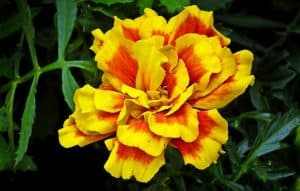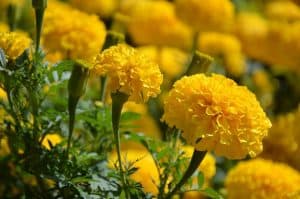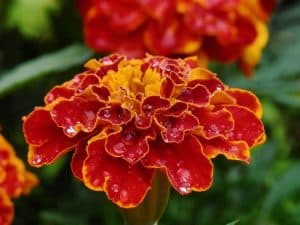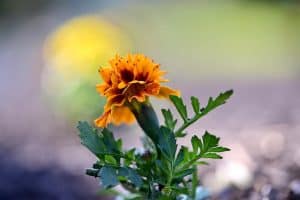Flower Glossary is reader-supported. When you buy through links on our site, we may earn an affiliate commission.
Marigold flowers continue to be a popular bloom for at-home gardeners. These full flowers with a ruffled appearance are both cheerful and incredibly low maintenance. Learn more about these vibrant plants and how easy it is to add them to your garden boxes.
Table of Contents
What are Marigold Flowers?

Marigolds are a popular annual garden flower due to their bright and cheery ruffled petals and tolerance to pests. The first record of marigold use was in a book published in 1552: the De La Cruz – Badiano Aztec Herbal. Around that time, early Spanish settlers took seeds from the Aztecs to transport back to Spain, and then to France and Africa.
As they spread, these gorgeous flowers took roots across cultures and religions. In Latin America, including Mexico, these stunning blooms decorated household altars for All Saints Day and All Souls Day. Those celebrating would also scatter these flowers around gravesites of family members who have passed on.
Those practicing the Hindu religion began using the flowers for religious ceremonies and to decorate statues of village gods during the harvest festival. The Aztecs themselves attributed the flowers to magic and religion.
By 1905, marigold flowers were exceptionally popular, largely due to the work of W. Atlee Burpee Seed Company. Burpee spent decades breeding these popular flowers, developing new colors, and improving their resistance to heat and drought. In 1939, the company released the very first marigold hybrid, which was shortly followed by a maroon-streaked flower.
Throughout the decades, his true pursuit was an all-white bloom. This desire led to a national marigold contest in 1954, with a $10,000 prize. A true white bloom was finally discovered during this contest in 1975.
Though Burpee popularized the flower, it’s not difficult to see why it’s remained a staple in many home gardens.
Find this flower in stunning colors for your own garden.
The Uses of Marigolds

The Aztecs were the first to grow marigolds—but they didn’t just grow them for their beauty and religious connections. They grew these beautiful flowers for medicinal reasons. The De La Cruz – Badiano Aztec Herbal of 1552 describes the use of these plants by the Aztecs in the treatment for hiccups, being struck by lightning, or for safe passage across rivers.
Though these uses seem elementary today, marigolds aren’t without healing properties. The flowers contain antiseptic and antibacterial properties that are effective for wound healing and easing pain caused by injuries like bee stings.
You can also turn the flowers into a poultice for burns or skin infections. When used as a cold eyewash infusion, these plants have also proven to be helpful in treating conjunctivitis. There is some belief that marigolds can also help with circulation disorders, such as varicose veins, and also for children’s scrofula and tuberculosis of the lymphatic system.
Different Types of Marigold Flowers
While there are hundreds of varieties of these colorful plants, there are only four different types. These include:
- African marigolds: A tall variety.
- French marigolds: A dwarf variety.
- Triploid marigolds: The African and French hybrids; typically multicolored.
- Single marigolds: Long stems; typically resemble daisies.
Some of the most popular varieties of marigolds include:
- Tagetes Cottage Red: A deep red flower with five petals, a golden center, and yellow edges.
- Baileya Multiradiata: A bright yellow flower with a wide yellow center.
- Park’s Whopper Yellow Marigold: A double blooming yellow flower with a sturdy stem. These feature short quills and rounded petals.
- Tagetes Erecta Sweet Cream: A creamy white flower that stands 16 inches tall and 3 inches wide on a sturdy stem.
- Tagetes Patula Aurora Light Yellow: A crimson and gold flower with deeply divided foliage.
How to Cultivate Marigold Flowers

Marigolds are a low maintenance flower, but they still require some know-how for planting. The first step in cultivating these flowers is to wait until there is no danger of frost and the soil is warm and dry for planting.
For most French and signet varieties, this means waiting until midsummer to plant them. Tall varieties are best planted in the spring since they take longer to mature. Here are easy steps for planting your marigolds:
- Wait for a shady or overcast day to plant your flowers. This will protect the seedlings as they cope with transplantation.
- Dig only one inch deep and at least 6 inches apart. You can keep them 1 inch apart when they are still seedlings, but you’ll need to thin them as they grow.
- Mix in granular fertilizer and moisten the soil.
If planting transplants:
- Dig down about 6 inches to loosen and aerate the soil. Remove any stones or debris.
- Place your plant in a hole about the size of a football. Add firm soil over the roots to give it support.
- Water each plant thoroughly.
Where to plant marigolds: These flowers must be planted in a spot that receives full sunlight. Don’t worry, they can withstand harsh summer temperatures! Be advised that if your flowers are planted in a shaded area or a cooler spot, they may form powdery mildew and won’t fully bloom.
If you’re planting seedlings, you can do so in containers with a soilless potting medium. During planting time, you can mix in a slow-acting granular fertilizer or plan to dilute liquid fertilizer over time. Though you can sow your seeds indoors, they germinate easily outdoors. You can sow them directly into the soil once the weather is warm and they’ll bloom in about 8 weeks.
Care Tips for Marigold Flowers

Thankfully, these vibrant flowers are very low maintenance plants and also very easy to grow. Despite this, there are a few things you should know to help them bloom at their best—keeping your garden full of color!
Marigold care tips:
- Deadheading improves the plant’s appearance and encourages further blooming.
- Marigolds like moderately fertile, well-drained soil, but they aren’t too picky. Be warned, clay soil will hinder their blooming slightly.
- These plants don’t really need fertilizer. In fact, it can even inhibit flower production. Though if the flowers are in a container, they may benefit from a diluted liquid fertilizer.
- Water your flowers at the base of the plant. The flower heads rot with too much moisture. Finally, allow the soil to completely dry between waterings.
- To propagate, allow flowerheads to fully dry and fade on the plant. Remove petals and shake out seeds.
- These plants aren’t too prone to diseases or pests, but they’ll get mold and root rot if they receive an abundance of moisture.
- These color flowers may deter deer, so they’re great to plant near others that attract deer.
- Once these flowers establish themselves, pinch the plant tops so they’re able to grow even fuller.
Marigolds are a popular garden flower because they are low maintenance and easy to grow. If you’re looking for even more easy-to-manage blooms, you’re in the right place. Learn more about perennials, medicinal plants, partial shade plants, and much more at Flower Glossary.